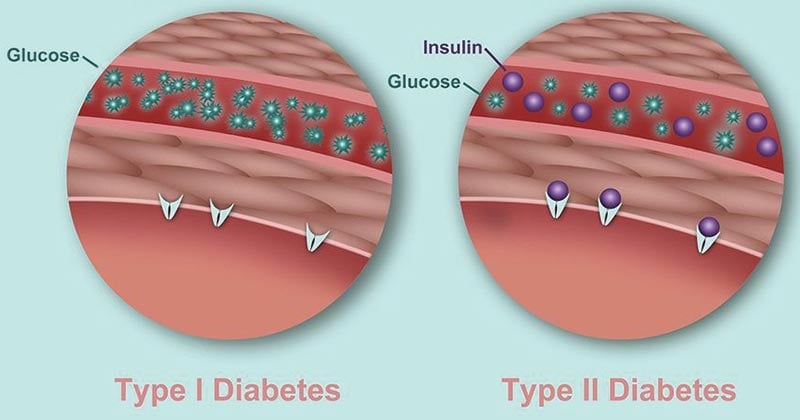
Image Source: Everyday Health. (Gwen Shockey/Alamy)
Differences between type 1 diabetes and type 2 diabetes
Features |
Type 1 diabetes |
Type 2 diabetes |
| Nature of disease | It is an autoimmune disease that occurs when the body’s immunity system mistakes insulin-producing cells as foreign invaders. | It is a metabolic condition where the pancreas produces enough insulin, but the body cannot utilize insulin. |
| Prevalence | Type 1 diabetes is not as prevalent or common as type 2 diabetes. | Type 2 diabetes is more prevalent. |
| Cause | Type 1 diabetes occurs when the body’s immunity system destroys the body’s own healthy cells like the insulin-producing beta cells in the pancreas, mistaking them for foreign invaders. | In type 2 diabetes, the body is unable to use the produced insulin effectively, which causes an increase in blood glucose levels. |
| Risk Factors | Factors like genetics, age, geography, and family history are considered as risk factors for type 1 diabetes. | Factors like age, exercise, blood sugar levels, body weight, and amount of belly fat, among others are considered as risk factors for type 2 diabetes. |
| Onset of symptoms | The onset of Type 1 diabetes is often sudden, and the symptoms appear within weeks in many patients. | The onset of Type 2 diabetes is mostly gradual, and the symptoms develop slowly over a period, with an average of 12 years. Some patients might not develop symptoms until complications appear. |
| Age of onset | Type 1 diabetes can occur at any age but most commonly begins at an early age, which is why it is also called juvenile diabetes. However, it might occur at a late stage also. | Type 2 diabetes mostly occurs at a later stage in life, especially in adults over the age of 30. |
| Symptoms | The usual symptoms of type 1 diabetes are the rapid onset of high blood sugar levels, resulting in weight loss, fatigue, thirst, and frequent urination. | The symptoms of type 2 diabetes might range from high blood glucose level, thirst, fatigue, urinary tract infection to neurological disorders. However, considering the slow onset of symptoms, mild symptoms like repeated infections and weakness are also common. |
| Complications | The short term complications of type 1 diabetes include hypoglycemia and ketoacidosis. Still, on long term exposure, it might cause damage to blood vessels with possible effects on heart and kidney, resulting in early mortality. | Because the symptoms appear very late in type 2 diabetes, the patients might have already developed complications at the time of diagnosis. Some of these complications include blindness, retinopathy, heart, and kidney diseases resulting in early mortality. |
| Body habitus | Type 1 diabetes is not associated with increased body weight and can occur in patients with thin or average body weights. | Type 2 diabetes I often associated with increased body weights, and obese people are at high risk for this disease. |
| Ketone bodies | The levels of ketone bodies in patients with type 1 diabetes are often higher than usual at diagnosis. Ketoacidosis is common in type 1 diabetes patients. | The level of ketone bodies is rarely affected by this disease. However, type 2 diabetes is linked with high blood pressure and increased cholesterol level at diagnosis. |
| Insulin Production | No insulin is produced in type 1 diabetes due to the destruction of insulin-producing cells. | In the case of type 2 diabetes, Insulin is produced in the body but isn’t used effectively. |
| Hypoglycemia | Episodes of hypoglycemia are frequent during type 1 diabetes. | The episodes of hypoglycemia are rare in type 2 diabetes, except when the patients might be taking insulin or some form of diabetes medicines. |
| Treatment | There is no cure for type 1 diabetes as the body doesn’t produce any insulin. Patients, thus, inject insulin regularly and even use insulin pumps to supply a steady flow of insulin in the body. | Type 2 diabetes can be controlled via proper dieting and exercise, but many patients need medication which is mostly adequate. |
| Prevention | There is no way known for the prevention of this disease. | Prevention and control of type 2 diabetes are possible through healthy eating and lifestyle habits. |
Interesting Science Videos
Reference
- https://www.healthline.com/health/difference-between-type-1-and-type-2-diabetes#treatment
- https://thediabeticjourney.com/5-differences-type-1-type-2-diabetes/
Sources
- 2% – https://www.ncbi.nlm.nih.gov/pmc/articles/PMC3114837/
- 2% – https://answersdrive.com/what-body-system-causes-diabetes-8011070
- 1% – https://www.webmd.com/diabetes/type-2-diabetes-symptoms
- 1% – https://www.webmd.com/diabetes/guide/understanding-diabetes-symptoms
- 1% – https://www.ncbi.nlm.nih.gov/pmc/articles/PMC3781542/
- 1% – https://www.ncbi.nlm.nih.gov/pmc/articles/PMC3671104/
- 1% – https://www.ncbi.nlm.nih.gov/pmc/articles/PMC2811457/
- 1% – https://www.ncbi.nlm.nih.gov/pmc/articles/PMC2797923/
- 1% – https://www.ncbi.nlm.nih.gov/pmc/articles/PMC2121151/
- 1% – https://www.medicinenet.com/diabetes_prevention/article.htm
- 1% – https://www.jdrf.org/t1d-resources/about/symptoms/adults/
- 1% – https://www.diabetes.org.uk/Diabetes-the-basics/What-is-Type-2-Diabetes
- 1% – https://www.betterhealth.vic.gov.au/health/conditionsandtreatments/diabetes-and-insulin
- 1% – https://diabetestalk.net/ketosis/how-does-ketoacidosis-cause-death
- 1% – https://care.diabetesjournals.org/content/diacare/28/12/2948.full.pdf
- 1% – http://www.bloodpressureuk.org/BloodPressureandyou/Yourbody/Diabetes
Medical Disclaimer: The information presented on the page is only for academic, study, and general information purposes. The information presented on the website must not be used for the purpose of medical advice or diagnosis or treatment. If you are not feeling well, please consult with your physician or doctor or qualified health care providers.
